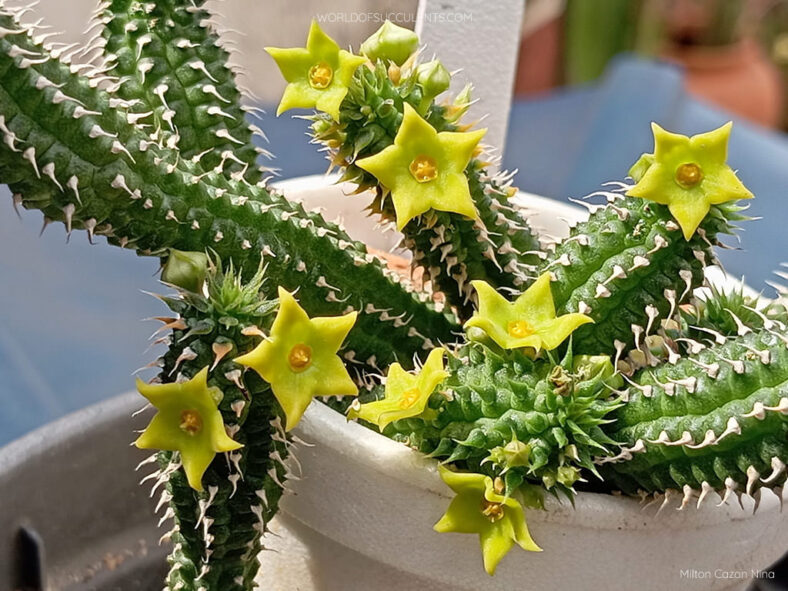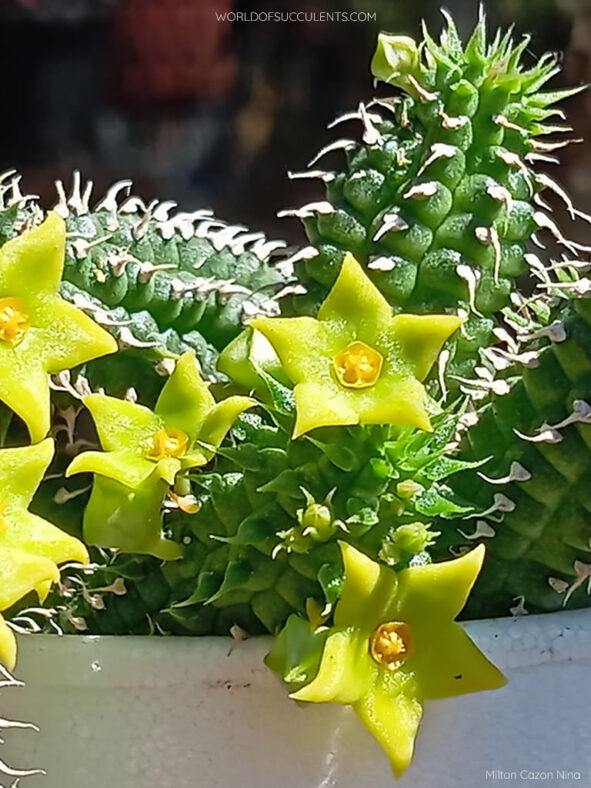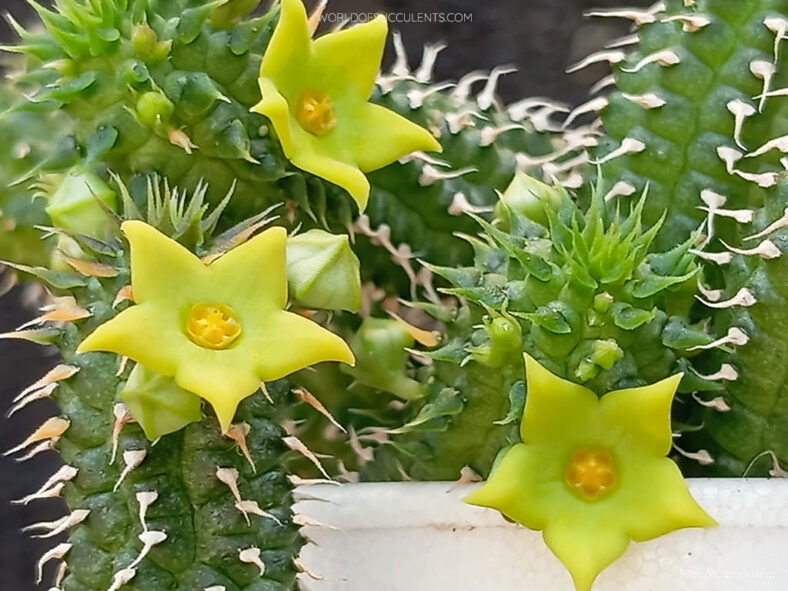Echidnopsis chrysantha resembles Echidnopsis planiflora, but it has slightly more campanulate, bright yellow flowers. In contrast, the flowers of Echidnopsis planiflora are more rotate in shape and can vary in color, ranging from brown to brownish suffused with yellow towards the center, as well as yellow and green.
Scientific Name
Echidnopsis chrysantha Lavranos
Synonym(s)
Ceropegia chrysanthoides, Echidnopsis planiflora subsp. chrysantha
Scientific Classification
Family: Apocynaceae
Subfamily: Asclepiadoideae
Tribe: Stapeliae
Genus: Echidnopsis
Etymology
The specific epithet "chrysantha" (pronounced "kris-ANTH-uh") means "having golden flowers" and refers to the golden yellow flowers of this species.
Origin
Echidnopsis chrysantha is native to northern Somalia and eastern Ethiopia.
Description
Echidnopsis chrysantha is a small succulent with stems with tubercles arranged in 8 to 12 ribs along their length. The stems are gray-green and typically grow about 4 inches (10 cm) long and 04 inches (1 cm) in diameter. The leaves that emerge from the tips of the tubercles are at least three times longer than they are wide at the base and remain persistent as dried-out spines.
In late summer and fall, Echidnopsis chrysantha produces attractive, golden-yellow flowers that can reach a diameter of 1 inch (2.5 cm). The corolla is slightly bell-shaped with deltoid lobes that curve backward. The corona is usually brownish.

Subspecies of Echidnopsis chrysantha
- Echidnopsis chrysantha subsp. chrysantha: This subspecies was discovered 2.5 miles (4 km) northwest of Erigavo in December 1968. It was first published by John Jacob Lavranos in the "Cactus and Succulent Journal (US)" in 1971.
- Echidnopsis chrysantha subsp. filipes: This subspecies was discovered in Somalia at the top of Dabagha Pass, located between El Gal and Durbo. It was first published by John Jacob Lavranos in "Cactus and Succulent Journal (US)" in 1974.
How to Grow and Care for Echidnopsis chrysantha
Light: Echidnopsis chrysantha prefers full sun but will benefit from light shade during the hottest summer days. Indoors, place the plant near the brightest window in your home, as it will stretch if it does not receive enough sunlight. Avoid abruptly moving a plant adapted to lower light levels to full sun to prevent sunburn.
Soil: Use a commercial potting soil mix for succulents or prepare your own by mixing 50% to 70% mineral grit, such as coarse sand, pumice, or perlite.
Temperature: The plant thrives in warm outdoor environments with low to moderate humidity. It does not like winter cold and should remain fairly dry and warm during its dormancy. Echidnopsis chrysantha is hardy in USDA Plant Hardiness Zones 10a-11b, which have average annual extreme minimum winter temperatures ranging from 30°F to 50°F (-1.1°C to 10°C).
Watering: It has typical watering needs for a succulent. During the growing season, from spring to fall, water the plant thoroughly and allow the soil to dry between waterings. When it goes dormant in winter, it requires almost no water, typically only once a month.
Fertilizing: Fertilizing is a good idea to keep the plant healthy and thriving. Feed it with water-soluble fertilizer diluted to half the recommended strength, but only when the plant is actively growing.
Repotting: Repot Echidnopsis chrysantha in spring, just before the growing season. It has shallow roots and does not require a lot of soil to grow. Always pick a container with drainage holes.
Propagation: The best way to propagate this succulent is by stem cuttings. To ensure good rooting, take cuttings during the growing season. The plant is also easy to start from seeds in the spring.
Learn more at How to Grow and Care for Stapeliads.
Toxicity of Echidnopsis chrysantha
Echidnopsis chrysantha has no reported toxic effects, making it safe for growing around children and pets.
Links
- Back to genus Echidnopsis
- Succupedia: Browse succulents by Scientific Name, Common Name, Genus, Family, USDA Hardiness Zone, Origin, or cacti by Genus
Photo Gallery
Click on a photo to see a larger version.


